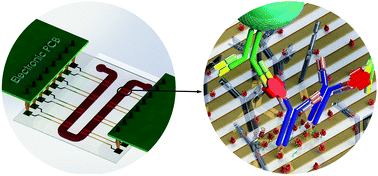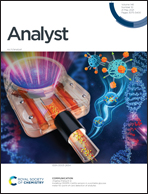A microfluidic microparticle-labeled impedance sensor array for enhancing immunoassay sensitivity†
Abstract
An impedimetric biosensor is used to measure electrical impedance changes in the presence of biomolecules from sinusoidal input voltages. In this paper, we present a new portable impedance-based biosensor platform to improve the sensitivity of immunoassays with microparticles as a label. Using a 2 × 4 interdigitated electrode array with a 10/10 μm electrode/gap and a miniaturized impedance analyzer, we performed immunoassays with microparticles by integrating a microfluidic channel to evaluate signal enhancement. First, to understand the material dependency of microparticles on the sensor array, magnetic, silica, and polystyrene microparticles were tested. Among these microparticles, magnetic microparticles presented a high signal enhancement with relevant stability from the sensor array. With the magnetic microparticles, we demonstrate a series of immunoassays to detect human tumor necrosis factor (TNF-α) and compare the level of signal enhancement by measuring the limit of detection (LOD). With the microparticles, we achieved over ten times improvement of LOD from sandwich immunoassays. By incorporating with sample preparation and flow manipulation systems, this impedance sensor array can be utilized for digital diagnostics for a real sample-in answer-out system.



 Please wait while we load your content...
Please wait while we load your content...